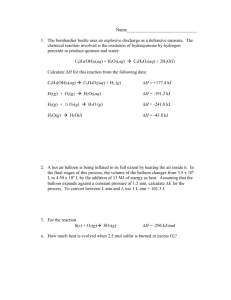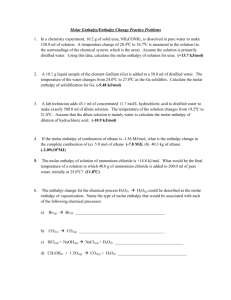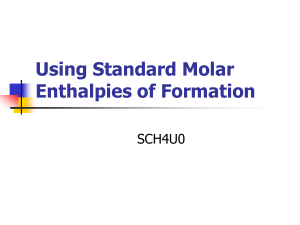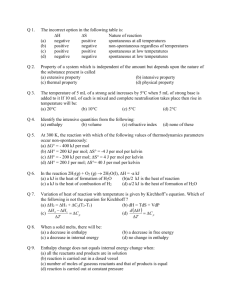Thermochemistry Worksheet: Enthalpy, Reactions, and More
advertisement
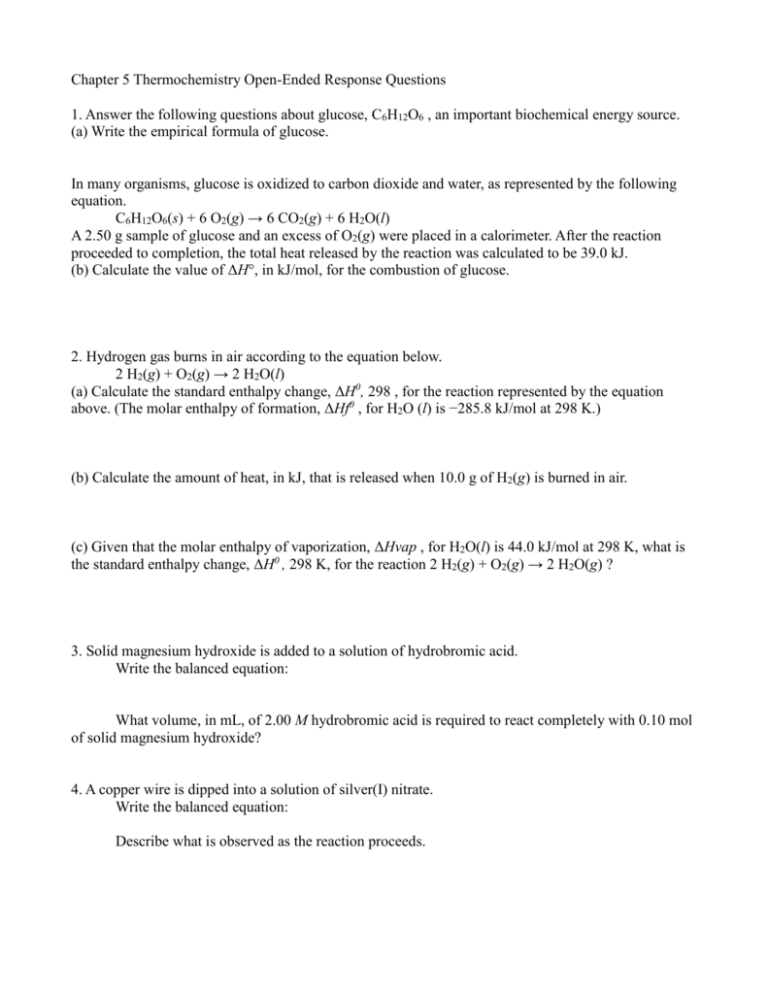
Chapter 5 Thermochemistry Open-Ended Response Questions 1. Answer the following questions about glucose, C6H12O6 , an important biochemical energy source. (a) Write the empirical formula of glucose. In many organisms, glucose is oxidized to carbon dioxide and water, as represented by the following equation. C6H12O6(s) + 6 O2(g) → 6 CO2(g) + 6 H2O(l) A 2.50 g sample of glucose and an excess of O2(g) were placed in a calorimeter. After the reaction proceeded to completion, the total heat released by the reaction was calculated to be 39.0 kJ. (b) Calculate the value of ΔH°, in kJ/mol, for the combustion of glucose. 2. Hydrogen gas burns in air according to the equation below. 2 H2(g) + O2(g) → 2 H2O(l) (a) Calculate the standard enthalpy change, ΔH0, 298 , for the reaction represented by the equation above. (The molar enthalpy of formation, ΔHf0 , for H2O (l) is −285.8 kJ/mol at 298 K.) (b) Calculate the amount of heat, in kJ, that is released when 10.0 g of H2(g) is burned in air. (c) Given that the molar enthalpy of vaporization, ΔHvap , for H2O(l) is 44.0 kJ/mol at 298 K, what is the standard enthalpy change, ΔH0 , 298 K, for the reaction 2 H2(g) + O2(g) → 2 H2O(g) ? 3. Solid magnesium hydroxide is added to a solution of hydrobromic acid. Write the balanced equation: What volume, in mL, of 2.00 M hydrobromic acid is required to react completely with 0.10 mol of solid magnesium hydroxide? 4. A copper wire is dipped into a solution of silver(I) nitrate. Write the balanced equation: Describe what is observed as the reaction proceeds. 5. A student performs an experiment to determine the molar enthalpy of solution of urea, H2NCONH2. The student places 91.95 g of water at 25°C into a coffee-cup calorimeter and immerses a thermometer in the water. After 50 s, the student adds 5.13 g of solid urea, also at 25°C, to the water and measures the temperature of the solution as the urea dissolves. A plot of the temperature data is shown in the graph below. (a) Determine the change in temperature of the solution that results from the dissolution of the urea. (b) According to the data, is the dissolution of urea in water an endothermic process or an exothermic process? Justify your answer. (c) Assume that the specific heat capacity of the calorimeter is negligible and that the specific heat capacity of the solution of urea and water is 4.2 J/g °C throughout the experiment. (d) Calculate the heat of dissolution of the urea in joules. (e) Calculate the molar enthalpy of solution, ΔHsoln , of urea in kJ/mol.

